1. Overview of Meaning
The kanji “戴” (dai) primarily means “to wear” or “to put on,” especially in the context of headwear or crowns. It can also imply respect or honor when referring to receiving something from someone of higher status.
2. Formation and Radical
Formation of the Kanji: The kanji “戴” is a compound character (会意文字) that combines elements to convey its meaning. The top part represents a head, while the bottom part suggests the act of wearing or placing something on the head.
Radical: The radical for “戴” is “頭” (head), which relates to its meaning of wearing something on the head.
3. Examples of Usage
Common Words and Phrases: Some frequently used words that include “戴” are “戴冠” (daikan – to crown) and “戴帽” (dai-bō – to wear a hat).
Example Sentences in Daily Conversation:
- 彼は王冠を戴いている。 (Kare wa ōkan o daite iru.) – He is wearing a crown.
- 彼女は新しい帽子を戴いた。 (Kanojo wa atarashii bōshi o daita.) – She put on a new hat.
4. Synonyms and Antonyms
Similar Kanji: A similar kanji is “着” (chaku), which also means “to wear,” but it is more general and can refer to clothing rather than specifically headwear.
Opposite Kanji: An antonym could be “脱” (datsu), which means “to take off” or “to remove,” indicating the opposite action of wearing something.
5. Cultural and Historical Background
Relation to Japanese Culture: The kanji “戴” is often associated with ceremonies and traditions, such as crowning a new leader or honoring someone with a title.
Proverbs and Idioms: One common expression is “戴天の恨み” (daiten no urami), which means “a grudge against heaven,” indicating a deep-seated resentment or grievance.
